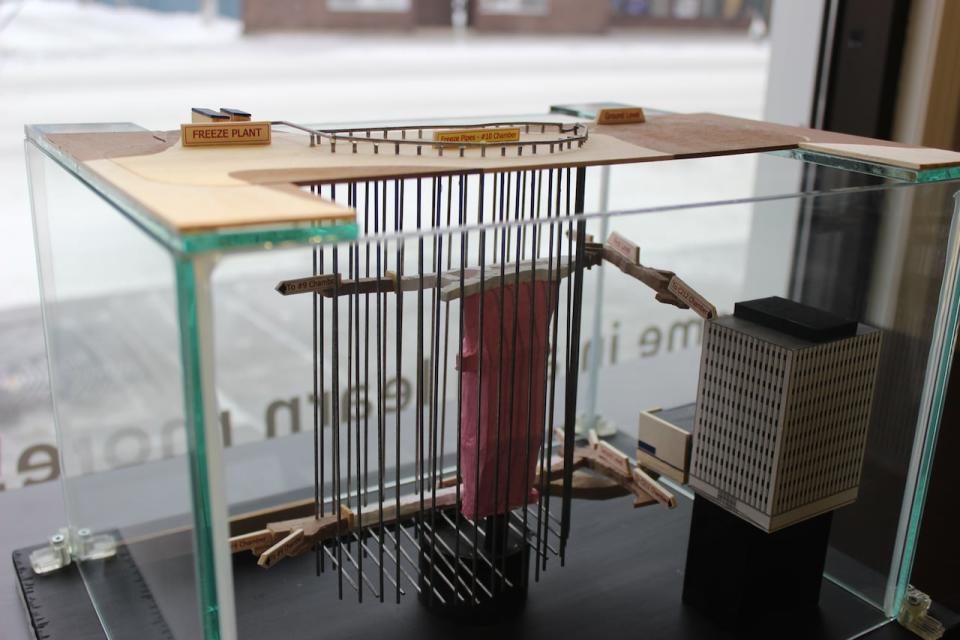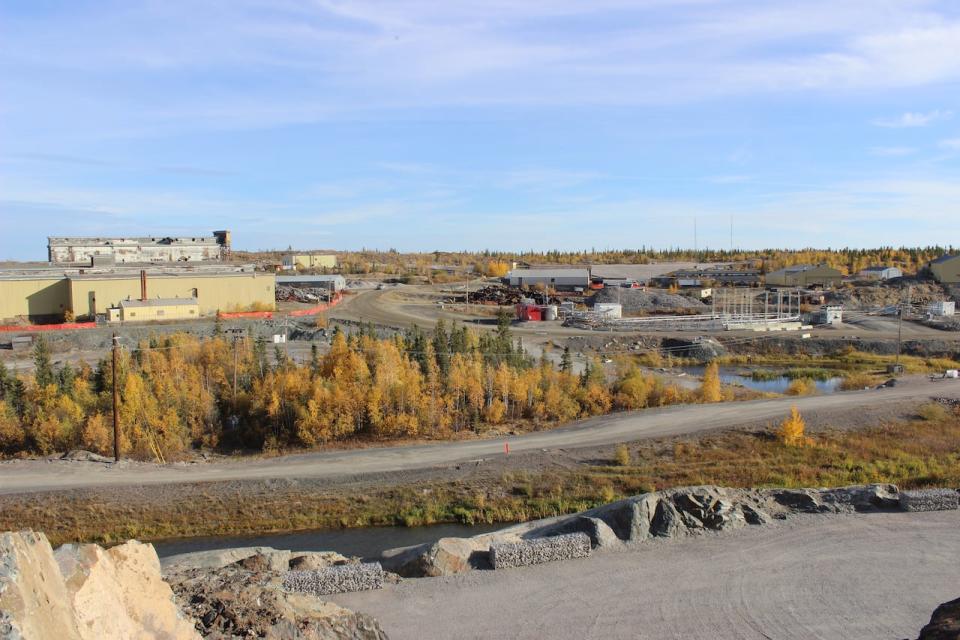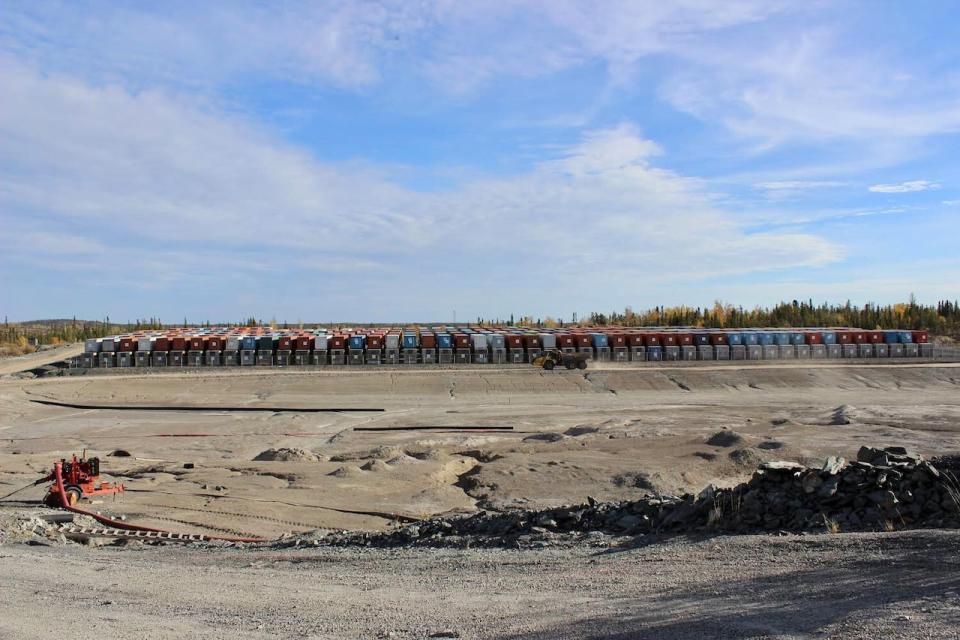Arsenic stored at Giant Mine not at risk from wildfire, says remediation director

An official with the Giant Mine remediation project says if wildfire were to reach the site there's no risk the 237,000 tonnes of water-soluble arsenic trioxide buried underground would leach into the environment.
"You have to remember that trioxide is between 80 and 250 feet below ground, it's entombed in rock and there's really no way for fire to get in at it," said Chris MacInnis, the director of the Giant Mine remediation project.
Giant Mine is within Yellowknife's municipal boundary. A number of wildfires burning near the N.W.T. capital forced the evacuation of most of the city's 22,000 residents a week ago. MacInnis said operations have been shut down at Giant Mine too, with employees evacuated and contractors pivoting to help with a massive firefighting effort.
The deal with thermosiphons
Dettah Chief Ed Sangris told CBC News earlier this week members of the Yellowknives Dene First Nation were worried fire would cause Giant Mine's thermosiphons — designed to keep the arsenic trioxide frozen below ground — to fail.
Thermosiphons at the remediation site are somewhat of a familiar sight for people living in Yellowknife, Dettah and Ndilǫ — distant but visible as you drive by Giant Mine along the Ingraham Trail.
The huge rods that stretch into the sky also have a portion buried deep underground.
Thermosiphons are the long-term solution for storing arsenic trioxide at Giant Mine, but they aren't relied upon yet to protect Yellowknife and the surrounding region from the poisonous dust stored below ground on the site in five stopes and 11 chambers.
Thirty-eight thermosiphons were installed around one of the chambers as a test project years ago. Only a dozen passive ones, which don't need electricity to work, are currently freezing the ground, said MacInnis. The remediation site will need 858 thermosiphons in total to freeze all the underground arsenic, 256 of which are scheduled to be installed starting in 2026.

This remediation site model at the Giant Mine Oversight Board office in January 2023 shows one of the arsenic chambers surrounded by 38 thermosiphons. These thermosiphons were part of a project that tested the freezing technology; 12 of them are passive, and are still working. The others, which rely on a freezing plant, are not currently in operation. (Liny Lamberink/CBC)
"That's part of our remediation project going into the future," explained MacInnis. What the remediation team is most concerned about, as wildfire threatens the city, is keeping water pumps running, he said.
Water pumps doing the protection work
Pumps at Giant Mine bring groundwater to the remediation site's surface, keeping water in the earth well below the chambers where the water-soluble dust is stored. If water were to reach those chambers, the arsenic trioxide might leach into the environment.
"We really don't want to saturate that dust, that would be our biggest risk," said MacInnis.

A settling pond at the Giant Mine site on Sept. 21, 2022. Beyond it is a polishing pond. Both are parts of the process that treats contaminated ground water before it is released into Baker Creek, which flows in Yellowknife Bay. (Liny Lamberink/CBC)
Though the remediation site has been shut down, MacInnis said power continues to flow to a series of pumps that send groundwater to a storage pond. From there, it's treated every summer and discharged into the environment.
"It's low risk, in general, for the fire even to get in at that pump," said MacInnis.
Even if pumps were to fail, MacInnis said it would take more than two years for groundwater to reach the arsenic chambers on its own. He said that's more than enough time to react by either fixing or replacing the pumps.
Contamination around Yellowknife
Some researchers who study contamination from the arsenic that settled over Yellowknife and the surrounding area during Giant's first years of operation are raising questions about what might happen to that substance during a fire.
"Fire coming through, it has the potential to alter and perhaps rerelease arsenic into the air," said Jules Blais, an environmental toxicology professor at the University of Ottawa.

A photo of part of the Giant Mine site, taken from on top of a flat surface where thermosiphon technology is going to be installed. On the right side of the photo, you can see a series of long shapes jutting up from the ground. That's a spot where thermosiphon technology was tested out. (Liny Lamberink/CBC)
Questions that could emerge following this year's wildfire season, Blais said, might be about whether arsenic was released into the air, and what effect that could have on air, soil and water.
"I suspect there might be physical and chemical changes as to how the landscape is recovering from this past contamination of arsenic," said Heather Jamieson, a professor emeritus at Queen's University's geological sciences and geological engineering department.
Preparing Giant for fire
MacInnis said before an evacuation order for Yellowknife, Dettah and Ndilǫ was issued, crews had already spent weeks bracing for fire near the remediation site.
The risk of the site burning, said MacInnis, is "pretty low."
"It's protected on one side by [Great Slave Lake], it's also protected by the large, vast tailings ponds and a lot of open barren landscape," he explained. Many of the buildings and infrastructure are situated at the core of the remediation site, "far enough away from an encroaching fire."

Giant mine's infamous gold roaster, which spewed arsenic trioxide into the air without any pollution controls from 1949 to 1951, is now stored in these 365 shipping containers. Their contents will eventually be buried in one of the pits and frozen by thermosiphons. (Liny Lamberink/CBC)
MacInnis said the remediation site was also firesmarted. Brush and vegetation was moved into the tailings ponds, and anything combustible that was out in the open was pushed into the site's core.
Contaminated materials from Giant's deconstructed roaster — which was responsible for spewing arsenic over the surrounding landscape in the mine's early operation — are stored in 365 shipping containers.
"They're shipping containers, so even if fire impacted them, they would likely stand," said MacInnis. "Even if anything was to be impacted there, because of where they're centrally located, we'll be able to handle any kind of release from them in through the water treatment system."


